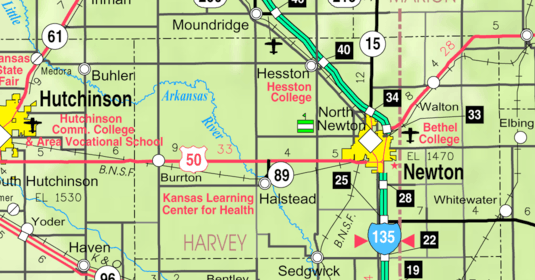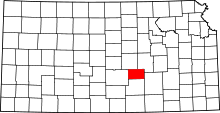Burrton, Kansas
| Burrton, Kansas | |
|---|---|
| City | |
 Location within Harvey County and Kansas | |
 KDOT map of Harvey County (legend) | |
| Coordinates: 38°1′21″N 97°40′20″W / 38.02250°N 97.67222°WCoordinates: 38°1′21″N 97°40′20″W / 38.02250°N 97.67222°W[1] | |
| Country | United States |
| State | Kansas |
| County | Harvey |
| Government | |
| • Type | Mayor–Council |
| • Mayor | Clark Kirk |
| • City Clerk | Kim Ryan |
| Area[2] | |
| • Total | 0.90 sq mi (2.33 km2) |
| • Land | 0.90 sq mi (2.33 km2) |
| • Water | 0 sq mi (0 km2) |
| Elevation[1] | 1,450 ft (442 m) |
| Population (2010)[3] | |
| • Total | 901 |
| • Estimate (2015)[4] | 895 |
| • Density | 1,000/sq mi (390/km2) |
| Time zone | CST (UTC-6) |
| • Summer (DST) | CDT (UTC-5) |
| ZIP code | 67020 |
| Area code | 620 |
| FIPS code | 20-09575 [1] |
| GNIS feature ID | 0477984 [1] |
| Website | burrtonkansas.com |
Burrton is a city in Harvey County, Kansas, United States.[1] It is named after Isaac T. Burr, former vice-president of the Atchison, Topeka and Santa Fe Railway.[5][6] As of the 2010 census, the city population was 901.[7]
History
19th century

For millennia, the land now known as Kansas was inhabited by Native Americans. In 1803, most of modern Kansas was secured by the United States as part of the Louisiana Purchase. In 1854, the Kansas Territory was organized, then in 1861 Kansas became the 34th U.S. state. In 1872, Harvey County was founded.
Burrton was laid out in 1873.[8] It was named from Burrton Township, which was named for I. T. Burr, a railroad official.[9] The first post office in Burrton was established in June 1873.[10] Burrton was incorporated as a city in 1878.[11]
Burrton's location at the junction of two railroads made it an important regional shipping point.[12]
Geography
Burrton is located at 38°1′21″N 97°40′20″W / 38.02250°N 97.67222°W (38.022573, -97.672316).[1] According to the United States Census Bureau, the city has a total area of 0.90 square miles (2.33 km2), all of it land.[2]
Demographics
| Historical population | |||
|---|---|---|---|
| Census | Pop. | %± | |
| 1880 | 386 | — | |
| 1890 | 695 | 80.1% | |
| 1900 | 627 | −9.8% | |
| 1910 | 689 | 9.9% | |
| 1920 | 679 | −1.5% | |
| 1930 | 649 | −4.4% | |
| 1940 | 842 | 29.7% | |
| 1950 | 749 | −11.0% | |
| 1960 | 774 | 3.3% | |
| 1970 | 808 | 4.4% | |
| 1980 | 976 | 20.8% | |
| 1990 | 866 | −11.3% | |
| 2000 | 932 | 7.6% | |
| 2010 | 901 | −3.3% | |
| Est. 2015 | 895 | [4] | −0.7% |
| U.S. Decennial Census | |||
2010 census
As of the census[3] of 2010, there were 901 people, 347 households, and 237 families residing in the city. The population density was 1,001.1 inhabitants per square mile (386.5/km2). There were 396 housing units at an average density of 440.0 per square mile (169.9/km2). The racial makeup of the city was 93.9% White, 0.4% African American, 1.1% Native American, 0.1% Asian, 2.7% from other races, and 1.8% from two or more races. Hispanic or Latino of any race were 6.2% of the population.
There were 347 households of which 36.0% had children under the age of 18 living with them, 54.5% were married couples living together, 9.8% had a female householder with no husband present, 4.0% had a male householder with no wife present, and 31.7% were non-families. 26.2% of all households were made up of individuals and 9.2% had someone living alone who was 65 years of age or older. The average household size was 2.60 and the average family size was 3.14.
The median age in the city was 36.2 years. 30.2% of residents were under the age of 18; 6.7% were between the ages of 18 and 24; 23.6% were from 25 to 44; 26.1% were from 45 to 64; and 13.4% were 65 years of age or older. The gender makeup of the city was 47.3% male and 52.7% female.
2000 census
As of the census[13] of 2000, there were 932 people, 361 households, and 251 families residing in the city. The population density was 1,520.9 people per square mile (589.9/km²). There were 402 housing units at an average density of 656.0 per square mile (254.4/km²). The racial makeup of the city was 93.78% White, 0.97% African American, 0.43% Native American, 2.25% from other races, and 2.58% from two or more races. Hispanic or Latino of any race were 5.15% of the population.[14][15]
There were 361 households out of which 33.0% had children under the age of 18 living with them, 57.1% were married couples living together, 8.9% had a female householder with no husband present, and 30.2% were non-families. 26.0% of all households were made up of individuals and 10.0% had someone living alone who was 65 years of age or older. The average household size was 2.58 and the average family size was 3.08.
In the city the population was spread out with 28.2% under the age of 18, 10.4% from 18 to 24, 28.8% from 25 to 44, 19.5% from 45 to 64, and 13.1% who were 65 years of age or older. The median age was 34 years. For every 100 females there were 96.2 males. For every 100 females age 18 and over, there were 93.9 males.
As of 2000 the median income for a household in the city was $33,646, and the median income for a family was $37,174. Males had a median income of $29,643 versus $21,477 for females. The per capita income for the city was $14,835. About 9.9% of families and 11.6% of the population were below the poverty line, including 18.4% of those under age 18 and 7.9% of those age 65 or over.
Education
Primary and secondary education
Burrton is part of Unified School District 369.[16][17]
Notable people
- Andy Dirks, professional baseball player for the Detroit Tigers.
- Milburn Stone, portrayed fictional Galen "Doc" Adams, M.D., of Dodge City on the long-running CBS western television series, Gunsmoke.
See also
- La Junta Subdivision, branch of the BNSF Railway
- Arkansas Valley Interurban Railway
Further reading
References
- 1 2 3 4 5 6 Geographic Names Information System (GNIS) details for Burrton, Kansas; United States Geological Survey (USGS); October 13, 1978.
- 1 2 "US Gazetteer files 2010". United States Census Bureau. Archived from the original on 2012-01-24. Retrieved 2012-07-06.
- 1 2 "American FactFinder". United States Census Bureau. Retrieved 2012-07-06.
- 1 2 "Annual Estimates of the Resident Population for Incorporated Places: April 1, 2010 to July 1, 2015". Retrieved July 2, 2016.
- ↑ The Homesteader; Volume 2 Issue 1; January 2006; ISSN 1559-3592
- ↑ The Atchison, Topeka, and Santa Fe Railway and Auxiliary Companies - Annual Meetings, and Directors and Officers; January 1, 1902
- ↑ "2010 City Population and Housing Occupancy Status". U.S. Census Bureau. Archived from the original on July 21, 2011. Retrieved March 6, 2011.
- ↑ History of the State of Kansas: Containing a Full Account of Its Growth from an Uninhabited Territory to a Wealthy and Important State. A. T. Andreas. 1883. p. 786.
- ↑ Kansas State Historical Society (1916). Biennial Report of the Board of Directors of the Kansas State Historical Society. Kansas State Printing Plant. p. 204.
- ↑ "Kansas Post Offices, 1828-1961 (archived)". Kansas Historical Society. Archived from the original on October 9, 2013. Retrieved 11 June 2014.
- ↑ History of the State of Kansas: Containing a Full Account of Its Growth from an Uninhabited Territory to a Wealthy and Important State. A. T. Andreas. 1883. p. 787.
- ↑ Blackmar, Frank Wilson (1912). Kansas: A Cyclopedia of State History, Embracing Events, Institutions, Industries, Counties, Cities, Towns, Prominent Persons, Etc. Standard Publishing Company. p. 259.
- ↑ "American FactFinder". United States Census Bureau. Archived from the original on 2013-09-11. Retrieved 2008-01-31.
- ↑ U.S. Census Bureau - 2000 Census, Population and Housing Unit Counts for Kansas
- ↑ U.S. Census Bureau - 1990 Census, Population and Housing Unit Counts for Kansas
- ↑ USD 369
- ↑ Kansas School District Boundary Map Archived July 21, 2011, at the Wayback Machine.
External links
| Wikimedia Commons has media related to Burrton, Kansas. |
- City
- Schools
- USD 369, local school district
- Historical
- Harvey County Genealogical Society
- Harvey County Roots
- Historic Images of Burrton, Special Photo Collections at Wichita State University Library
- Maps
- Burrton City Map, KDOT
- Harvey County Maps: Current, Historic, KDOT
